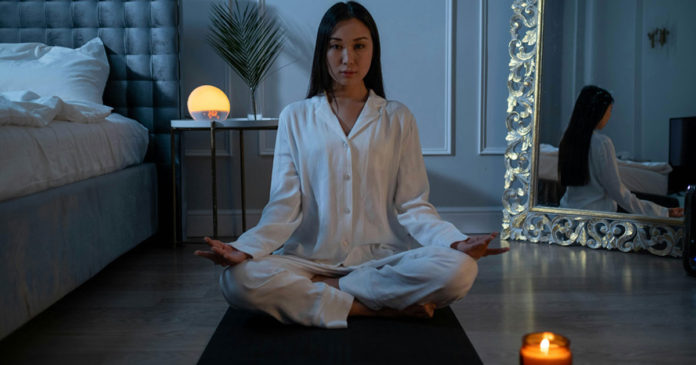People all across the world have been meditating for a very long period. It is obvious how beneficial it is to our physical, mental, and emotional well-being. Even though there are different places to meditate, different people are curious to learn more about the connection between darkness and meditation. the ideal environment for meditation is one that is completely dark and seals out outside light. In total darkness, you may either lay down or sit and allow yourself to enter a profound level of relaxation and introspection. People are more inclined to reflect on their inner life when they meditate in the dark.
You could benefit from trying to meditate in the dark for a number of reasons. By obstructing your view of visible objects, it initially increases your awareness. Because we are less prone to get sidetracked by other factors, as we meditate in the dark, we may focus on ourselves and learn to know ourselves better.
Moreover, you could feel calm and comfortable after doing your meditation at night. It is a calm space where individuals may escape the outer world and find serenity inside themselves because of the darkness in the room.
Additionally, some individuals think that spending time alone in the dark may facilitate introspection and a deeper connection to one’s spiritual side. We may unearth secret areas of our thoughts or become more alert when we are completely darkened. Remember that some people have trouble falling asleep at night. Prior to engaging in such behavior, individuals who are afflicted with specific physical or mental health conditions should consult a mental health professional.
This article will go over several crucial factors including the advantages and disadvantages of trying to meditate in the dark. To practice this kind of meditation, there are numerous techniques. It may also aid in your overall increase in awareness if ever you want to meditate in the dark. Come with me on this fascinating journey into the odd and eerie realm of meditation!
The Science Behind Meditating in the Dark: How Light (or Lack Thereof) Affects Your Brain
Many find solace in the calm and tranquility that meditation offers, having practiced it for hundreds of years. However, have you ever considered how your meditation practice can be impacted by light—or lack thereof? People’s interest in the effects of darkness on the brain and methods for relaxing there has increased in recent years.
The absence of light causes a series of biological responses in our brains that occur while we meditate in the dark. The way it modifies our brain waves is one significant aspect. Theta and alpha brain waves may be elevated while sitting in the dark, per studies. These are patterns associated with intense concentration, inspiration, and resting states.
Another significant way that light affects meditation is the release of melatonin. The hormone melatonin regulates our sleep and waking cycles. It plays a significant role in our circadian rhythm. When it turns dark, a hormone known as melatonin is produced, which promotes deeper meditation and relaxation.
Hence, when we meditate in the dark, we may take advantage of these physiological and neurological processes that occur naturally in our bodies. One of its advantages is that it helps one disconnect from external distractions and stimuli that might impede deep attention.
Keep in mind that although total darkness could be advantageous for some people, it might not be suitable or safe for others. You should always seek the advice of a medical expert or a qualified meditation teacher before trying to meditate in the dark or making any major modifications to your meditation practice.
Furthermore, if you’re having trouble focusing and de-stressing during your meditation sessions, you may want to try to meditate in the dark. Always put your security and well-being first. Additionally, you need to consider seeking expert help if required. Savor the thought process!
The Pros and Cons of Meditating in the Dark
The merits and demerits of trying to meditate in the dark are contingent upon individual preferences and life experiences.
When you meditate in the dark, there’ a possibility that it can improve your ability to focus and concentrate is one of the nicest things about it. Eliminating distractions from their senses may help people become more conscious and concentrate on the here and now. Moreover, the lack of illumination can induce feelings of solitude and serenity, enabling individuals to concentrate more intently on their workout.
However, it’s equally critical to consider the negative outcomes of trying to meditate in the dark. Some individuals may find it unsettling or frightening to meditate in the dark. Your thoughts and emotions may intensify while you are blind, leaving you feeling more exposed or insecure. Hence, it’s crucial to consider your level of comfort with this activity before attempting to meditate in the dark.
Moreover, not everyone may be able to practice meditation in complete darkness. Lack of light may make it difficult for those who rely on external signals or guided imagery to meditate.
Before beginning this therapy, anyone with certain medical conditions or mental health concerns should see a physician.
There are, in conclusion, both positive and negative aspects of trying to meditate in the dark. While some individuals find this an ideal setting for concentration and attention, others could find the lack of light unsettling or frightening. Prior to determining if this technique aligns with your aspirations for your meditation practice, consider your own preferences and comfort zone.
Practical Tips for Meditating in the Dark: Setting Up Your Space for Optimal Experience
Your meditation experience may be greatly enhanced by creating an environment that is conducive for trying to meditate in the dark. Eliminating outside distractions may improve your ability to focus and induce a state of inner calm. This section will go over some helpful pointers for arranging your space so that your nighttime meditation practice is as productive as possible.
Ensuring total darkness in the space where you concentrate is a crucial consideration. For complete light blockage from external sources, use curtains or blackout shades. You might decide to put on an eye mask or hood to further block off light entering the space.
Another crucial aspect to consider is the alteration of the illumination conditions in your vicinity. Dim lighting, such as from candles or low-lighting bulbs, may create a calming atmosphere as you meditate in the dark. Try out a variety of lights to see which one best meets your needs.
Additionally, you may make your meditation space a more tranquil place by tidying it and getting rid of any debris. Remove anything extraneous or distracting that might interfere with your ability to concentrate while you meditate in the dark.
Alternative Approaches: Combining Light and Darkness for a Balanced Meditation Practice
To achieve a focused and peaceful state of mind, individuals might experiment with several types of meditation techniques, such as trying to meditate in the dark. An alternative technique to meditation that is gaining greater traction is combining light and darkness.
When practicing how to meditate in the dark, often referred to as twilight or dusk meditation, you should make sure the space is calm and has little lighting. This method helps individuals concentrate their attention inside, away from external distractions, and into their inner selves. Dim lighting may provide a calming atmosphere that promotes introspection and relaxation.
Lantern meditation is an additional technique that involves using a single candle to concentrate the attention. You may utilize the gentle, moving flame as a source of soft light as well as a focal point. This approach may help one develop mindfulness and a sense of tranquility.
Using guided thinking in low light is another technique to include light and dark into your meditation practice. Dim lighting and guided imagery techniques may encourage individuals to engage their imaginations while maintaining a peaceful environment. This strategy allows you to profoundly relax while exploring your inner worlds via visuals.
Blending light and dark may help practitioners access various sections of their minds and experience different levels of consciousness during meditation. By careful reflection, various forms of meditation, such as guided visualization in low light, candlelight meditation, meditation in the dark, meditation at sunset or twilight, and so on, may help individuals develop a deeper connection with themselves and enhance their general well-being.
The Personal Choice: Finding What Works Best for You – Experimenting with Different Environments
Finding the ideal location for meditation may greatly improve both the experience and outcomes of your workout. Everyone has distinct preferences and desires for their quiet area. By experimenting with various settings, you can determine which one works best for you.
You have the option to attempt meditation in the dark. Some individuals find that by completely shutting off external distractions and meditate in the dark as they are better able to concentrate on their inner experience. This might improve your overall meditation experience by making you feel more at ease and reflective.
But keep in mind that not everyone is able to work out in the dark. When considering various meditation locations, it’s critical to consider what suits each individual the best. Some individuals may prefer environments with gentle lighting and natural light because they find them calming.
Examine many locations for meditation before settling on the most comfortable one for you. You could try moving to new locations, such as those that are peaceful or have background noise like calming music or natural noises, whether they are inside or outside. To create an environment that promotes relaxation and concentration, consider other factors such as temperature, scent, and your own comfort level.
Remember at all times that there isn’t a single, ideal location for meditation. It’s about figuring out what suits you best and creating an environment that fosters inner awareness and calm while assisting you in your practice.
Embracing Flexibility – Choosing Between Light and Darkness Based on Your Unique Needs
Lastly, there’s no better way to get to know yourself better and become more receptive to change in your meditation practice than to meditate in the dark. By choosing between bright and dark meditation environments depending on their own requirements, different individuals may tailor their experiences to their plans and objectives.
One is able to filter out external distractions and concentrate solely on one’s own thoughts and emotions when meditating in the dark. Your senses might sharpen and your awareness of the current moment can increase while you are blind.
On the other hand, sitting in the light might make you feel more enlightened and lucid. Some people report that it makes them feel more connected to the environment and broad and open while meditating.
The lightness or darkness you chose for your meditation should ultimately be determined by your own preferences, your objectives, and yourself.While some people flourish under bright light, others find comfort in darkness.
Remember that there are no right or wrong ways to relax. You must determine what is most effective for you and modify your practice accordingly.
You may develop, discover inner peace, and discover more about yourself by choosing to either sink your teeth into the dark or shine brightly.












